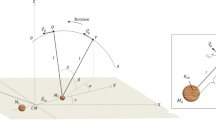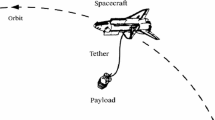Abstract
The tether slingshot technique, which is based on the exchange of angular momentum between a satellite and a platform, is analyzed here with the goal of maximizing the satellite lifetime after release. Once the tether is deployed and the system librates about the local vertical, the tether is cut twice: the first time at the platform end in order to increase the apogee height of the satellite-tether system and later on at the satellite end in order to increase the perigee height of the satellite. The goal is to define the conditions at the end of deployment and the timing and parameters of the two cuts in order to maximize the satellite lifetime. Two separate strategies are followed: (a) the first tether cut occurs when the libration angle reaches a critical value for which the tether crosses the local vertical (with prograde libration) at the second apogee passage, i.e., when the second cut provides the maximum increase of perigee altitude; and (b) the first cut takes place when the tether crosses the local vertical and the true anomaly at the second tether cut is taken as an additional free parameter of the optimization process. In both strategies we assume, at first, that the maximum lifetime corresponds to the minimum semi-major axis decay rate or, conversely, to the maximum increase of the satellite perigee. Since increasing perigee height means sacrificing apogee height, the assumption above is tested by directly computing the satellite lifetime as a function of the free parameters in order to refine the estimate of the optimal cut parameters. The orbital-parameters-oriented approaches (a) and (b), together with the direct computation of the lifetime, allow us to select the end-of-deployment and cut parameters which maximize the satellite lifetime.
Similar content being viewed by others
References
COLOMBO, G. “The Use of Tethers for Payload Orbit Transfer,” NASA Report NAS8-33691, 1982.
MISRA, A. K., AMIER, Z. E., and MODI, V. J. “Effect of Attitude Dynamics on Tether Propulsion,” Proceedings of the Space Tethers for Science in the Space Station Era, Vol. 14, 1988. pp. 468–473.
KUMST, K., KUMST, R., and MISRA, A. K. “Effects on Deployment Rates and Libration on Tethered Payload Raising,” Journal of Guidance, Control, and Dynamics, Vol. 15, No. 5, 1992, pp. 1230–1235.
PELAEZ, J., and LORENZINI, E. C. “Sensitivity Analysis of Tether-Mediated Orbital Injections,” Journal of the Astronautical Sciences, Vol. 44, No. 4, 1996, pp. 491–514.
HARRISON, J. K. “SEDS/SEDSAT Project Overview,” Proceedings of the Fourth International Conference on Tethers in Space, Vol. 1, 1995, pp. 85–94.
LORENZINI, E. C., MOWERY, D. K., and RUPP, C. C. “Dynamics and Control SEDSAT Deployment,” Proceedings of the Fourth International Conference on Tethers in Space, Vol. 1, 1995, pp. 551–562.
RUIZ, M., PELAEZ, J., and LORENZINI, E. C. “Stability of Pendular Motion of a Tethered System in an Elliptical Orbit,” Paper No. 96–202, AAS/AIAA Space Flight Mechanics Meeting, Austin, Texas, February 1996.
SCHECHTER, H. B. “Dumbbell Libration in Elliptical Orbit,” AIAA Journal, Vol. 2, June 1964, pp. 1000–1003.
MODI, V. J., and BRERETON, R. C. “Libration Analysis of a Dumbbell Satellite Using the WKBJ Method,” Journal of Applied Mechanics, Vol. 33, No. 3, 1966, pp. 676–678.
MODI, V. J., and BRERETON, R. C. “Periodic Solutions Associated with Gravity-Gradient-Oriented Systems: Part I. Analytical and Numerical Determination,” AIAA Journal, Vol. 7, July 1969, pp. 1217–1225.
MODI, V. J., and BRERETON, R. C. “Periodic Solutions Associated with Gravity-Gradient-Oriented Systems: Part II. Stability Analysis,” AIAA Journal, Vol. 7, August 1969, pp. 1465–1468.
TING, L. “Optimum Orbital Transfer by Impulses,” Journal of the American Rocket Society, Vol. 30, No. 11, 1960, pp. 1013–1018.
KING-HELE, D. G., SCOTT, D. W., and WALKER, M. C. “Upper-Atmosphere Rotational Speed and its Variations with Height,” Planetary Space Science, Vol. 18, October 1970, pp. 1433–1445.
Author information
Authors and Affiliations
Corresponding author
Rights and permissions
About this article
Cite this article
Peláez, J., Ruiz, M. & Lorenzini, E.C. Strategies for Maximizing a Satellite Lifetime by Tether-Mediated Orbital Injection. J of Astronaut Sci 45, 205–231 (1997). https://doi.org/10.1007/BF03546377
Published:
Issue Date:
DOI: https://doi.org/10.1007/BF03546377




